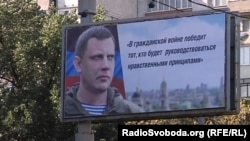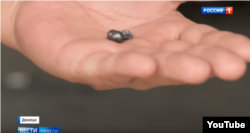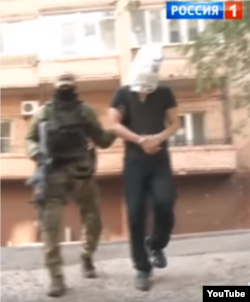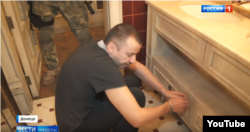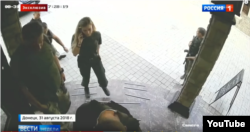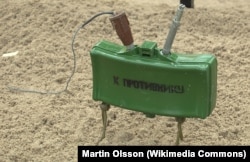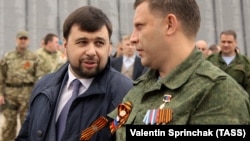A report that aired on Sunday, September 30 during Dmitry Kisleyov’s weekly current affairs and analytical program, “News of the Week,” featured exclusive CCTV footage showing the August 31 assassination Aleksandr Zakharchenko, former head of the self-proclaimed Donetsk People’s Republic (DNR).
In the footage, Zakharchenko, accompanied by an entourage, can be seen entering the antechamber of the “Separatist” café when a bomb goes off, killing him and one of his guards, Vyacheslav Dosenka.
The report noted that a bomb with the equivalent of 1.5 kilograms of TNT was placed in the ceiling of the anteroom and rigged up to the café’s electrical wiring. Shrapnel from the bomb – iron balls -- are presented by the investigator, Aleksandr Konoplya.
The segment’s reporter, Alexander Rogatkin, said that the placement of the bomb would have necessitated the anteroom ceiling being taken down, requiring a ladder. That, coupled with the explosive device’s connection to the electrical wiring, would, in his words, have had to been prepared “carefully” and for “a long time.”
According to Konoplya, a man of Zakharchenko’s height would have passed through the vestibule in “two to three steps.” That would have provided a very small window to carry out the strike. Konoplya therefore concluded Zakharchenko would have been under close surveillance, possibly from someone at the scene of the attack, with microphones or even video surveillance, leading to speculation that he was being monitored by the café’s CCTV system.
The report notes that special services in the DNR have not provided footage of the bomb’s installation itself.
A man with a bag over his head is then presented for the cameras. The “suspect,” whom the report names as Oleksandr Pogorelov, is identified as the man who “planted the bomb” that killed Sparta Batallion leader Arsen “Motorola” Pavlov in October 2016.
Pogorelov, in handcuffs, then goes on to show Rogatkin how he planted both the bomb and the camera in the elevator of Pavlov’s apartment, as well as a device under the bathroom sink at Café Pushkin during a "foiled attempt" on Zakharchenko’s life in 2017. This alleged attempt on Zakharchenko’s life has not been verified.
Pogorelov then describes how his “Kyivian curator Sergei” had planned the operation at the Separatist Café with another group.
“[The bomb] worked through an antenna, through a link that worked two kilometers away despite the interference of homes and other obstructions. Ideally, it worked perfectly without interference.”
He added that, according to Sergei, the device was “an American production that was given by American intelligence.”
According to the report, Zakharchenko’s convoy was equipped with a special radio-jamming system with a functional range of several dozen square meters. That further leads an anonymous DNR operational officer to conclude that “the devices were transferred from foreign intelligence.”
Several points of the report remain unclear.
Pogorelov was first arrested in 2017. The report never elucidates how an alleged agent, who claims to have been recruited by Ukrainian intelligence in 2014, would have operational knowledge of another group which carried out the assassination in late August of the following year. That his handler would divulge information on the equipment provided by a foreign intelligence service to another group carrying out another high-level attack many months down the line strains credulity.
There are also questions regarding the alleged remote control system used to detonate the device and claims of Zakharchenko having a special radio-jamming system. An unidentified female in Zakharchenko’s entourage places a call on her cellphone the moment she steps out of the vehicle after the convoy pulls up to the café. She trails Zakharchenko by several feet, never putting the phone down, right up until the moment the bomb goes off.
The report makes no mention of how a person would be speaking via cellphone in the immediate vicinity of an engaged radio-jamming system.
But even then, remotely detonated devices are by no means indicative of specially acquired Western equipment. Radio and mobile-phone detonated improvised explosive devices (IEDs) are a staple of insurgent combatants the world over, and the Irish Republican Army managed infrared-light triggered IED’s nearly three decades ago, which were later employed by insurgents in Iraq to circumvent radio jamming systems.
But if a member of Zakharchenko’s entourage was able to use a cellphone when the attack took place, it follows that less sophisticated means of detonation would have been available.
Regarding the explosive device itself, its 1.5 kilogram TNT equivalent and fragmentation presented in the video could just as well indicate a far less technologically advanced device like the Soviet manufactured MON-50 Claymore-shaped anti-personal mine. No evidence has been presented showing a highly-sophisticated bomb was used.
It also remains uncertain why no CCTV footage was available showing the “long, careful” installation of the bomb in the ceiling.
But blame for Ukrainian security services was almost a fait accompli.
Sergey Beseda, a high-ranking officer of Russia’s Federal Security Service, pinned culpability on the SBU days after the bombing took place, before any such evidence would have been available.
As reported by RT, acting DNR head Denis Pushilin similarly claimed that DPR investigators had analyzed the remains of the explosive device that killed Zakharchenko, identifying technology that hadn’t previously been used by the SBU.
Interestingly, a number of Western ordnance specialists declined to comment for this article – no indication of fault since none of them appeared to be involved in Ukraine, though perhaps a signal of the sensitivity of the subject.
Our conclusion: Russian media reports are inconclusive and only serve to raise more questions about the assassination of Zakharchenko




